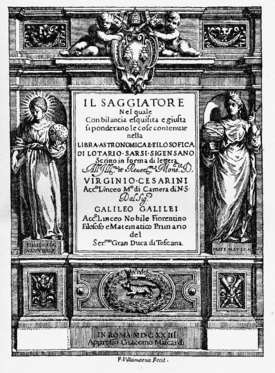The Assayer

The Assayer (Italian: Il Saggiatore) was a book published in Rome by Galileo Galilei in October 1623 and is generally considered to be one of the pioneering works of the scientific method, first broaching the idea that the book of nature is to be read with mathematical tools rather than those of scholastic philosophy, as generally held at the time.
Grassi on the comets
The context of the essay was to reply to the treatise Libra astronomica ac philosophica of 1619 by Orazio Grassi, a Jesuit mathematician at the Collegio Romano, which used the pseudonym of Lotario Sarsi Sigensano. The debate between Galileo and Grassi started in 1618, when the latter published Disputatio astronomica de tribus cometis anni MDCXVIII, in which he asserted that comets are celestial bodies. Grassi adopted Tycho Brahe's Tychonic system, in which the other planets of the solar system orbit around the sun, which, in turn, orbits around the earth. In his Disputatio Grassi referenced many of Galileo's observations, such as the surface of the moon and the phases of Venus, without mentioning him. Grassi argued from the apparent absence of observable parallax that comets move beyond the moon. Galileo mistakenly believed that comets are an optical illusion.
Mathematics and philosophy in The Assayer
In 1616 Galileo may have been silenced on Copernicanism. In 1623 his supporter and friend, Cardinal Maffeo Barberini, a former patron of the Accademia dei Lincei and uncle of future Cardinal Francesco Barberini, became Pope Urban VIII. The election of Barberini seemed to assure Galileo of support at the highest level in the Church. A visit to Rome confirmed this. The Assayer is a milestone in the history of science: here Galileo describes the scientific method, which was quite a revolution at the time, given the prevalence of scholasticism, which, instead of relying on the observation of nature to make assumptions, relied heavily on ipse dixit.
The title page of The Assayer shows the crest of the Barberini family, featuring three busy bees. In The Assayer, Galileo weighs the astronomical views of a Jesuit, Orazio Grassi, and finds them wanting. The book was dedicated to the new pope. The title page also shows that Urban VIII employed a member of the Lynx, Cesarini, at a high level in the papal service. This book was edited and published by members of the Lynx.
In The Assayer Galileo mainly criticized Grassi's method of inquiry, heavily biased by his religious belief and based on ipse dixit, rather than his hypothesis on comets. Furthermore, he insisted that natural philosophy (i.e. physics) should be mathematical. According to the title page, he was the philosopher]] (i.e. physicist) of the Grand Duke of Tuscany, not merely the mathematician. Natural philosophy (physics) spans the gamut from processes of generation and growth (represented by a plant) to the physical structure of the universe, represented by the cosmic cross-section. Mathematics, on the other hand, is symbolized by telescopes, and an astrolabe. This is the book containing Galileo’s famous statement that mathematics is the language of science. Only through mathematics can one achieve lasting truth in physics. Those who neglect mathematics wander endlessly in a dark labyrinth. From the book:[1]
| “ | Philosophy [i.e. physics] is written in this grand book — I mean the universe — which stands continually open to our gaze, but it cannot be understood unless one first learns to comprehend the language and interpret the characters in which it is written. It is written in the language of mathematics, and its characters are triangles, circles, and other geometrical figures, without which it is humanly impossible to understand a single word of it; without these, one is wandering around in a dark labyrinth. | ” |
Galileo used a sarcastic and witty tone throughout the essay. The book was read with delight at the dinner table by Urban VIII.[2] In 1620 Maffeo Barberini wrote a poem entitled Adulatio Perniciosa in Galileo's honor.[3] An official, Giovanni di Guevara, said that The Assayer was free from any unorthodoxy.[4]
See also
References
- ↑ Galileo Galilei, The Assayer, as translated by Stillman Drake (1957), Discoveries and Opinions of Galileo pp. 237-8.
- ↑ Amir Alexander (2014). Infinitesimal: How a Dangerous Mathematical Theory Shaped the Modern World. Scientific American / Farrar, Straus and Giroux. ISBN 978-0374176815., p. 131
- ↑ The Galileo Project
- ↑ William A. Wallace, Galileo, the Jesuits and the Medieval Aristotle, (1991), pp.VII, 81-83
Sources
- Galileo Galilei, Il Saggiatore (in Italian) (Rome, 1623); The Assayer, English trans. Stillman Drake and C. D. O'Malley, in The Controversy on the Comets of 1618 (University of Pennsylvania Press, 1960).
- Pietro Redondi, Galileo eretico, 1983; Galileo: Heretic (transl: Raymond Rosenthal) Princeton University Press 1987 (reprint 1989 ISBN 0-691-02426-X); Penguin 1988 (reprint 1990 ISBN 0-14-012541-8)
External links
- PDF version of the full text of "The Assayer" - Stanford Unversity
- Galileo, Selections from The Assayer - Princeton University
